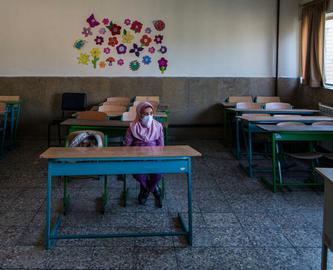The first 10 days of Muharram are over. The holy month, the time when Shias mourn the martyrdom of Imam Hossein in 680, is traditionally marked by public ceremonies and processions. The summer holidays have also come to a close and the school year is about to get underway. Both events have been the source of intense worry among both large parts of the public and many officials, and there is widespread expectation that there will be a jump in the number of coronavirus cases across the Islamic Republic.
During Muharram, despite repeated warnings by health officials, many Iranian cities witnessed packed mourning ceremonies and tourists, with some particularly popular holiday destinations hosting large numbers of visitors.
On August 30, numerous videos of these packed religious gatherings, breeding grounds for coronavirus, were posted on social media. In the holy city of Qom, despite a ban by Qom’s Islamic Development Organization on large procession on Ashura, the 10th day of Muharram and the day when Imam Hossein was martyred, a number of processions rushed toward the Shrine of Masoumeh, the daughter of the 7th Shia Imam. Videos and photographs posted online show some people taking part in the procession breaking barriers to enter the courtyard of the shrine to mourn.
Nevertheless, domestic news agencies pretended that such events did not happen and everything went according to plan. For example, the Islamic Republic News Agency (IRNA) reported that worshippers, following health guidelines and without processions, gathered in the courtyard of Masoumeh Shrine to mourn.
Commenting on the consequences of holding these ceremonies and people’s holiday travels, First Deputy Health Minister Iraj Harirchi said: “Unfortunately, in the coming week we shall witness an increase in the number of outpatients. After two or three weeks the number of hospitalizations will rise and after four to six weeks we shall see an increase in the number of coronavirus fatalities.”
He reported that the most popular travel destinations during the holidays were the provinces of Gilan, Mazandaran, Golestan, Isfahan and East Azerbaijan, despite the fact that these provinces are all in a red, or emergency, state of alert. According to Harirchi, on Thursday, August 27, there were 2,566,000 inter-province travels, an increase of nine percent compared to the same day last year, long before the outbreak of coronavirus.
Schools Due to Re-open
Now that the Muharram holidays and the most important mourning days are over, Iranian officials and people face a new serious challenge: the reopening of schools and universities, scheduled for September 5.
Education minister Mohsen Haji-Mirzaei reiterated that reopenings will take place on schedule and, except in areas in a red state of alert, students will attend school. “In places where there is no access to the internet, television can provide students with necessary educational programs,” he said.
“In 35 percent of schools where the number of students is below 50 and where social distancing is possible, classes will be held as usual but even in other schools in-person classes are not out of the question and they remain the default,” said Haji-Mirzaei. “But, in the remaining 65 percent of schools, if social distancing is not possible, we will still hold classes in person but we will divide the students into two groups. One group will attend classes on odd days and the other on even days.”
He emphasized the importance of in-person classes, but conceded that in some cases compliance with health protocols would not be possible. Therefore, he said, schools will not reopen in areas in a red state of alert. In areas in a yellow state of alert, schools will reopen, albeit with a limited number of students. Students, he said, will be notified by their schools of the exact arrangement.
Many parents, however, expressed worry that their children would be infected with coronavirus if they attended school. This came amid reports from Kerman that 245 young people in the six to 18-year-old age group had been infected.
“Until early June there were very few hospitalizations of patients under 15 years of age in the hospitals run by Kerman University of of Medical Sciences but then the second peak of the epidemic started and reached its zenith in July,” said Mehdi Shafiei, the universities spokesman. “We had 245 inpatients in the school-age group [six to 18] and, unfortunately, some died. And this happened when people did not have much personal contact with one another.”
Shafiei warned that as schools reopened, students’ behavior could not be controlled. He said that the commute to school, parents gathering near the school and other social situations could create chains of transmission among students. This would be dangerous both to them and to older people, he said, especially if the risk of influenza is taken into account. He emphasized that the risk of influenza cases as fall approached could not be predicted.
Masoud Saghafi, spokesman for the Tehran Education Bureau, said that classes will be held remotely in the city when schools reopen on September 5 because Tehran is in a red state of alert.
Provinces Round-up and Daily Briefing
The total Covid-19 death toll in Alborz province has reached 942, according to Mohammad Fathi, the president of Alborz University of Medical Sciences. He said that since the outbreak of the epidemic, 15,311 people have been hospitalized in the province with coronavirus symptoms, of whom 14,762 tested positive for the virus. According to him, of the current 415 patients currently hospitalized in Alborz with coronavirus symptoms, 125 are confirmed Covid-19 patients.
In her daily briefing for August 31, the health ministry spokeswoman Dr. Sima Sadat Lari reported that as of August 31, 13 provinces were in a red state of alert and 15 provinces were in an orange, or serious state of alert.
- Red: Tehran, Mazandaran, Gilan, Qom, Isfahan, Razavi Khorasan, East Azerbaijan, Kerman, North Khorasan, Semnan, Yazd, Zanjan and Qazvin
- Orange: West Azerbaijan, Alborz, Fars, Lorestan, Hormozgan, Ardabil, Bushehr, Kermanshah, Kohgiluyeh and Boyer Ahmad, South Khorasan, Markazi, Ilam, Chaharmahal and Bakhtiari, Golestan and Khuzestan
Dr. Lari also announced the official coronavirus statistics for the past 24 hours:
- New confirmed coronavirus cases: 1,624
- New hospitalizations: 573
- Total cases since the outbreak: 375,212
- Total coronavirus tests conducted in Iran: 3,231,110
- Total recovered from coronavirus: 323,233
- New fatalities: 109
- Total death toll since the outbreak: 21,571
This is part of IranWire's coronavirus chronology. Read the full chronology
visit the accountability section
In this section of Iran Wire, you can contact the officials and launch your campaign for various problems


























comments